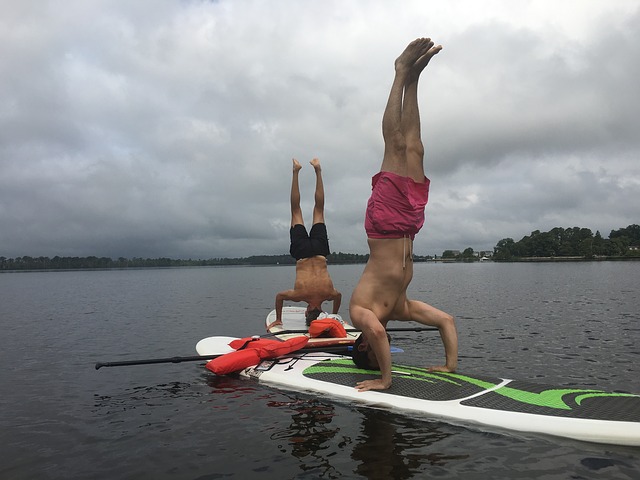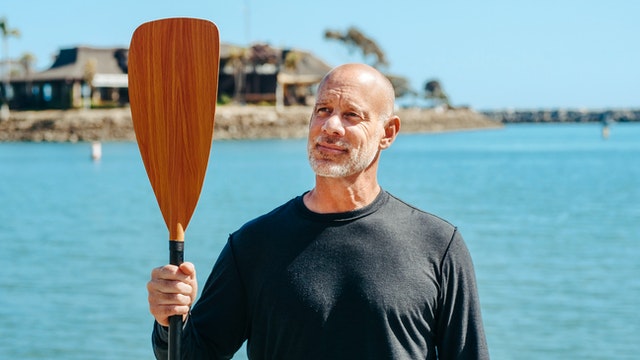Paddleboarding is fun, but you need to put in the work like everything else. Before enjoying the swells and touring the different rivers and lakes with friends and family, you must know how to stand on a paddleboard. The cool part is that it is pretty easy, it might take some getting used to, but if you follow all the instructions to the letter, it would be like an evening stroll in the park.
Paddleboard for beginners: SUP 101, class in session
It is crucial not to mistake kayaking with paddleboarding. While they have some things in common, you should set aside what you already know about kayaking to sponge up the paddleboarding experience.
Do not beach your paddleboard
If you are a total newbie to paddleboarding, you should start your training in knee-deep waters free from any obstacles. The water should be just deep enough for the paddleboard fins not to get grounded.

Find the board’s center
The next of the many tips on how to stand up on a paddleboard is to find the board’s center, and this is usually where the handle is located, at least on most boards. You should gently pull yourself onto the board’s center in a kneeling position with both hands across the board, holding it steady.
Adjust Slowly
If you are slightly off-center, you should continue to grip the board’s edges as you shuffle your feet one after the other back into position. Moving quickly could cause the paddleboard to lose balance and have you back in the water.
You can always revisit this kneeling position if you feel uncomfortable on the water. It allows you quickly find your bearing in unfavorable conditions.
Chest up, then knees up
You should be on all fours on the board with the paddle clenched in your fist when ready to stand up. The first step is to slowly raise your chest until vertical with both your knees still bent before you move your foot (one at a time) to the position where your knees were.
Begin paddling the moment you are standing on the board to gather momentum. Building momentum makes it easier to stay on the board and paddle for longer.
Mounting the Board

You do not just find yourself on a paddleboard; you must mount it. Frankly speaking, mounting the board is much less of a challenge than standing on the board. You are likely to get this on your first try. Let’s get to it.
Stand beside your board knee-deep in water deep enough not to get your board’s fin beached. You can stand on either side of the board, preferably one that makes you feel more comfortable.
The next step is to put the paddle across the board with the handle being on the side of the board closer to you. After which, you should grip the paddle handle with the board with one hand while the other hand goes across to hold the board’s other edge.
All that’s left to do is mount the board. You do this by lifting one leg, the one closer to the board and placing it on the padding on the board, which is usually in the center of the board, the same place you can find the handle.
Shift your body weight as you move the board underneath your body with your other knee placed in the center of the board. You should take a few strokes to get some momentum before slowly attempting to stand on the paddleboard.
How To Balance on a SUP

It is one thing to mount your paddleboard or to stand on it. But a completely different ball game to maintain your balance as you paddle away. Check out the following tips on how to keep your balance on a SUP:
The secret is the placement of your feet. They should be centered around the board’s edges, parallel and hip-distance away from each other. Your back should be straight, your knees bent slightly, and your toes pointing forward.
You should ensure to use your paddle as much as possible. It being in the water gives you more stability and more maneuverability. One common rookie mistake is to look at your feet constantly. Looking around affects your center of gravity and could put yourself and your craft in peril.
Remember to keep your shoulders and head steady and only shift your weight using your hips. You should avoid pinching down on the board with your feet when the ride gets bumpy. It would cause you to use up more energy and leave you with sore feet when you get off the board.
Getting the Right Gear
You are only as good as your gear. If you have a defective paddleboard, it would matter little what you learn here as the board would make it difficult to put any into practice. Continue reading to find out the equipment you need in your toolbox and why.
Stand Up Paddleboard (SUP)
You can not go stand-up paddleboarding without a paddleboard. This entry should almost go without saying, but it is crucial because there are several types of paddleboards. The different board types have different characteristics due to being made from different materials, making them ideal for various things. Some are sleek, sporty and light, ideal for sporting competitions, and others are affordable, perfect for training. Your choice of board must reflect your need.
Paddle

The board can not move by itself, so you need a paddle. It resembles a canoe paddle only that the blade is teardrop-shaped for maximum efficiency. There are two types of paddles. Fixed-length paddles with a stiff, lightweight construction are the go-to for pros. Adjustable paddles are the preferred option for newbies due to the design flexibility that makes them suitable for several uses.
Personal Floatation Device (PFD)
The US Coast Guard requires you to have a PFD onboard operating your paddleboard outside a swimming area. The PFD should be on children at all times, while adults are not mandated to have it on. You should check your state’s regulations before hitting the water.
Safety Light and Whistle
You must have a safety whistle for your safety and warn boaters in your vicinity. You also need to have a light source onboard if you would be staying on the water after dark.
Leash
Even the most experienced paddlers fall off their board, and the board might be difficult to recover in challenging conditions. This is where the leash joins the fray. It tethers you to the board, and because the board is floatable, having a leash connected to it can be a lifesaver in some unsavory situations. You should endeavor to purchase the right one as there are leashes for flat water, rivers or surf.
Transporting Your Paddleboard

Paddleboards are very large, and getting them to your destination requires some planning and intentional thinking. The following are ways you can move your board around and make a problematic task that much easier.
Air Travel
If you are traveling a relatively far distance, you should consider airplane travel. This is a preferred option because there are a variety of padded paddleboard bags for your consideration. I always advise that you add some padding of your own with bubble wrap or towels. You should find out how much more you need to pay before booking your flight.
Handle Carry
Some boards have handles in the middle of the board, making it easy to transport them wherever you intend to launch the board. You need to lift it by the handle and be on your way.
Car Racks
If you have a surfboard soft rack, you can use it to strap your paddleboard to your car. You can also strap your board to your vehicle’s rack with some cars fitted with locks that prevent your board from being stolen. Sometimes you do not even need to overthink it. You can put some towels on the roof, your board goes on the towels, and you can use straps running through your car doors to fix the board in place.
Shoulder Carry
Holding the paddle in one hand, with the nose on the ground, lift the board from the tail with the nose. Walking toward the board, you should shift the board on your head before letting the board gently rest on your shoulders.
Summary
There you have it, all you need to know about mounting a paddleboard, answers to the how to stand on a paddleboard question, maintaining your balance and the correct gear for a wholesome paddleboarding experience. The world, or rather, the water, is your oyster. Happy paddling!
